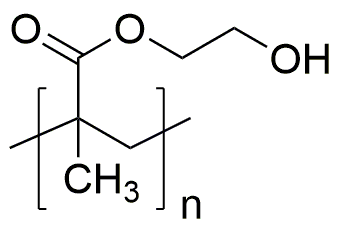Poly(2-hydroxyethyl methacrylate) is widely utilized in research focused on:
- Biomedical Applications: This compound is used to create hydrogels for drug delivery systems, allowing for controlled release of medications in a targeted manner, which enhances therapeutic efficacy.
- Contact Lenses: It serves as a key material in the production of soft contact lenses, providing excellent moisture retention and comfort for users.
- Coatings and Adhesives: The chemical is employed in formulating coatings that offer superior adhesion and durability, making it ideal for various industrial applications.
- Wound Dressings: Its biocompatibility makes it suitable for use in wound dressings, promoting healing while preventing infection.
- Cosmetic Products: It is incorporated into skincare formulations for its ability to create a smooth texture and improve moisture retention, enhancing product performance.
General Information
Properties
Safety and Regulations
Applications
Poly(2-hydroxyethyl methacrylate) is widely utilized in research focused on:
- Biomedical Applications: This compound is used to create hydrogels for drug delivery systems, allowing for controlled release of medications in a targeted manner, which enhances therapeutic efficacy.
- Contact Lenses: It serves as a key material in the production of soft contact lenses, providing excellent moisture retention and comfort for users.
- Coatings and Adhesives: The chemical is employed in formulating coatings that offer superior adhesion and durability, making it ideal for various industrial applications.
- Wound Dressings: Its biocompatibility makes it suitable for use in wound dressings, promoting healing while preventing infection.
- Cosmetic Products: It is incorporated into skincare formulations for its ability to create a smooth texture and improve moisture retention, enhancing product performance.
Documents
Safety Data Sheets (SDS)
The SDS provides comprehensive safety information on handling, storage, and disposal of the product.
Product Specification (PS)
The PS provides a comprehensive breakdown of the product’s properties, including chemical composition, physical state, purity, and storage requirements. It also details acceptable quality ranges and the product's intended applications.
Certificates of Analysis (COA)
Search for Certificates of Analysis (COA) by entering the products Lot Number. Lot and Batch Numbers can be found on a product’s label following the words ‘Lot’ or ‘Batch’.
*Catalog Number
*Lot Number
Certificates Of Origin (COO)
This COO confirms the country where the product was manufactured, and also details the materials and components used in it and whether it is derived from natural, synthetic, or other specific sources. This certificate may be required for customs, trade, and regulatory compliance.
*Catalog Number
*Lot Number
Safety Data Sheets (SDS)
The SDS provides comprehensive safety information on handling, storage, and disposal of the product.
DownloadProduct Specification (PS)
The PS provides a comprehensive breakdown of the product’s properties, including chemical composition, physical state, purity, and storage requirements. It also details acceptable quality ranges and the product's intended applications.
DownloadCertificates of Analysis (COA)
Search for Certificates of Analysis (COA) by entering the products Lot Number. Lot and Batch Numbers can be found on a product’s label following the words ‘Lot’ or ‘Batch’.
*Catalog Number
*Lot Number
Certificates Of Origin (COO)
This COO confirms the country where the product was manufactured, and also details the materials and components used in it and whether it is derived from natural, synthetic, or other specific sources. This certificate may be required for customs, trade, and regulatory compliance.


